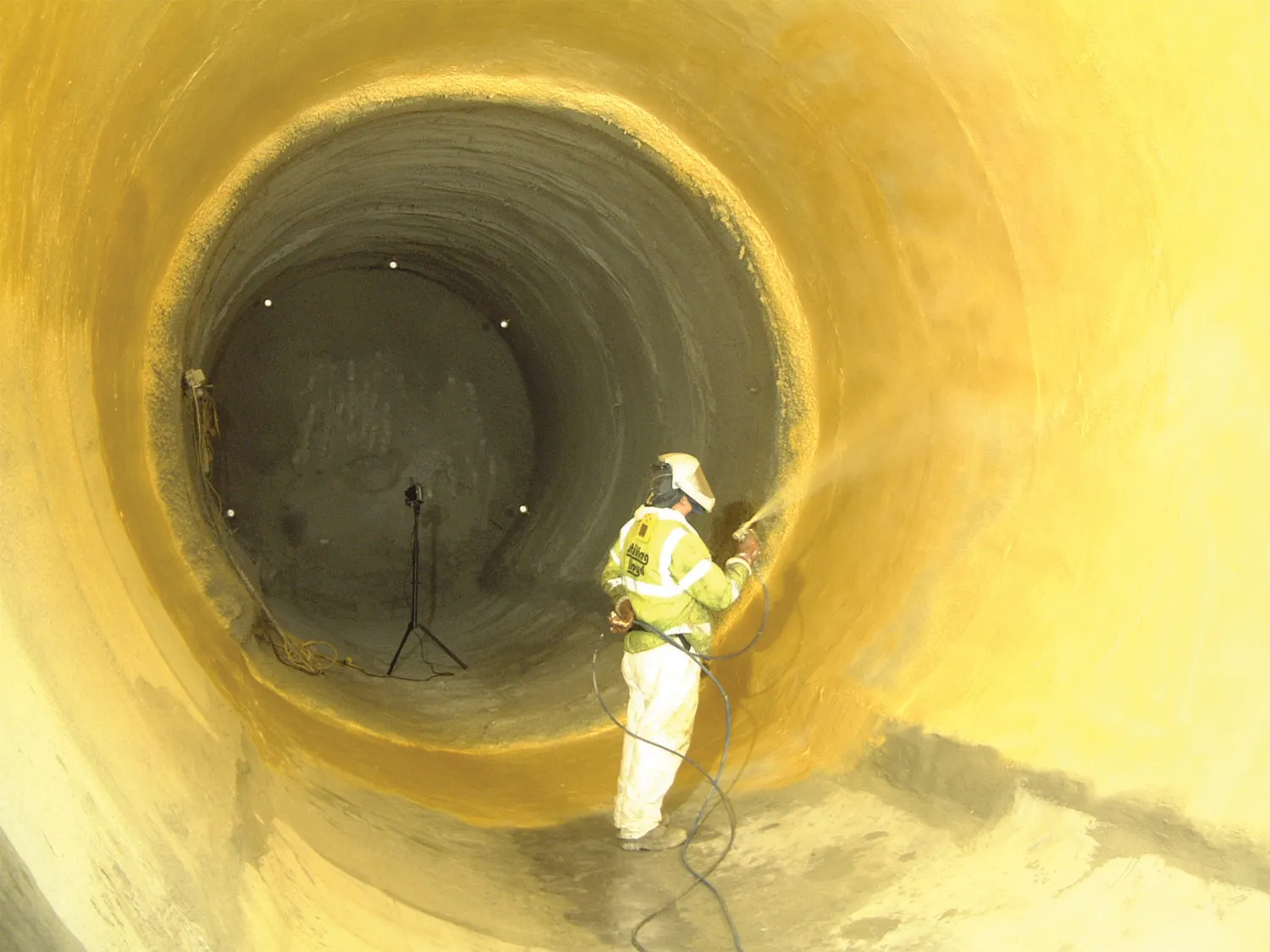Sprayed waterproofing: 'hot topic' Sprayed waterproofing is a hot industry topic, and a paper presented at the recent North American Tunnelling Conference not only discussed this method for achieving a dry tunnel but also how it can reduce build costs and construction time.
February 10, 2012
Read time: 3 mins

Sprayed waterproofing: 'hot topic' Sprayed waterproofing is a hot industry topic, and a paper presented at the recent North American Tunnelling Conference not only discussed this method for achieving a dry tunnel but also how it can reduce build costs and construction time.
In traditional SCL-SEM-NATM [Sprayed Concrete Lining-Sequential Excavation Method-New Austrian Tunnelling Method] tunnel construction, regardless of the thickness of concrete sprayed to form the primary lining, from a structural perspective this concrete is ignored, says2314 Stirling Lloyd.
According to the company, the full structural load is supported by the final or secondary lining. A sheet membrane is then tacked to various points of the primary concrete but it is not fully bonded. This compromises the choice for the final lining as it is exceptionally difficult to get sprayed concrete to bond to a sheet membrane system: the sprayed concrete tends to rebound off the membrane surface. This effect can be reduced by the use of lattice girders and reinforcing steel mesh to help support the sprayed concrete during application.
However, this tends to have a detrimental effect on the quality of the final lining as achieving adequate compaction of sprayed concrete through a network of steel reinforcement is difficult, resulting in voids and failure to passivate the steel against corrosion from ground water when it is not adequately encapsulated.
As a consequence the construction method currently favoured for final linings tends to be traditionally reinforced cast in-situ concrete. This is much slower than spraying concrete, claims Stirling Lloyd.
"The great design benefit of spray applied waterproofing, such as Stirling Lloyd's Integritank HF membrane, is that the final lining can be permanent sprayed concrete instead of cast in-situ concrete.
With no requirement for fibre reinforcement, traditional lattice girders and rebars, build speed is increased and cost reduced."
Colin Eddie from2567 Morgan Sindall Underground Professional Services takes the view that, depending on the design of the tunnel, cost savings of up to 50% are achievable with a sprayed solution, when considering the waterproofing and final lining taken together.
The most significant advance that a fully bonded sprayed membrane offers is the composite effect, between the primary and secondary sprayed concrete layers, says Stirling Lloyd.
In construction which includes sprayed waterproofing, the primary and secondary concrete layers are both fully and intimately bonded to the membrane. Consequently, unlike when using sheet systems, both the concrete layers are acting together and therefore both the primary and secondary linings contribute to the load bearing capability of the tunnel.
"Research carried out by Morgan Sindall, both in its Underground Professional Services division at Rugby, England and supported by further work at2568 Warwick University to test this theory have shown that two concentric rings of sprayed concrete, bonded together by Stirling Lloyd's Integritank HF tunnel waterproofing membrane, behave in the same way as a monolithic ring of the same dimensions,"says Stirling Lloyd.
"While earlier work had suggested that a mechanical key between the concentric rings is required by way of an uneven interface, the Warwick University work shows that this is not the case, and even with a smooth interface the full effect is achieved."
In traditional SCL-SEM-NATM [Sprayed Concrete Lining-Sequential Excavation Method-New Austrian Tunnelling Method] tunnel construction, regardless of the thickness of concrete sprayed to form the primary lining, from a structural perspective this concrete is ignored, says
According to the company, the full structural load is supported by the final or secondary lining. A sheet membrane is then tacked to various points of the primary concrete but it is not fully bonded. This compromises the choice for the final lining as it is exceptionally difficult to get sprayed concrete to bond to a sheet membrane system: the sprayed concrete tends to rebound off the membrane surface. This effect can be reduced by the use of lattice girders and reinforcing steel mesh to help support the sprayed concrete during application.
However, this tends to have a detrimental effect on the quality of the final lining as achieving adequate compaction of sprayed concrete through a network of steel reinforcement is difficult, resulting in voids and failure to passivate the steel against corrosion from ground water when it is not adequately encapsulated.
As a consequence the construction method currently favoured for final linings tends to be traditionally reinforced cast in-situ concrete. This is much slower than spraying concrete, claims Stirling Lloyd.
"The great design benefit of spray applied waterproofing, such as Stirling Lloyd's Integritank HF membrane, is that the final lining can be permanent sprayed concrete instead of cast in-situ concrete.
With no requirement for fibre reinforcement, traditional lattice girders and rebars, build speed is increased and cost reduced."
Colin Eddie from
The most significant advance that a fully bonded sprayed membrane offers is the composite effect, between the primary and secondary sprayed concrete layers, says Stirling Lloyd.
In construction which includes sprayed waterproofing, the primary and secondary concrete layers are both fully and intimately bonded to the membrane. Consequently, unlike when using sheet systems, both the concrete layers are acting together and therefore both the primary and secondary linings contribute to the load bearing capability of the tunnel.
"Research carried out by Morgan Sindall, both in its Underground Professional Services division at Rugby, England and supported by further work at
"While earlier work had suggested that a mechanical key between the concentric rings is required by way of an uneven interface, the Warwick University work shows that this is not the case, and even with a smooth interface the full effect is achieved."









